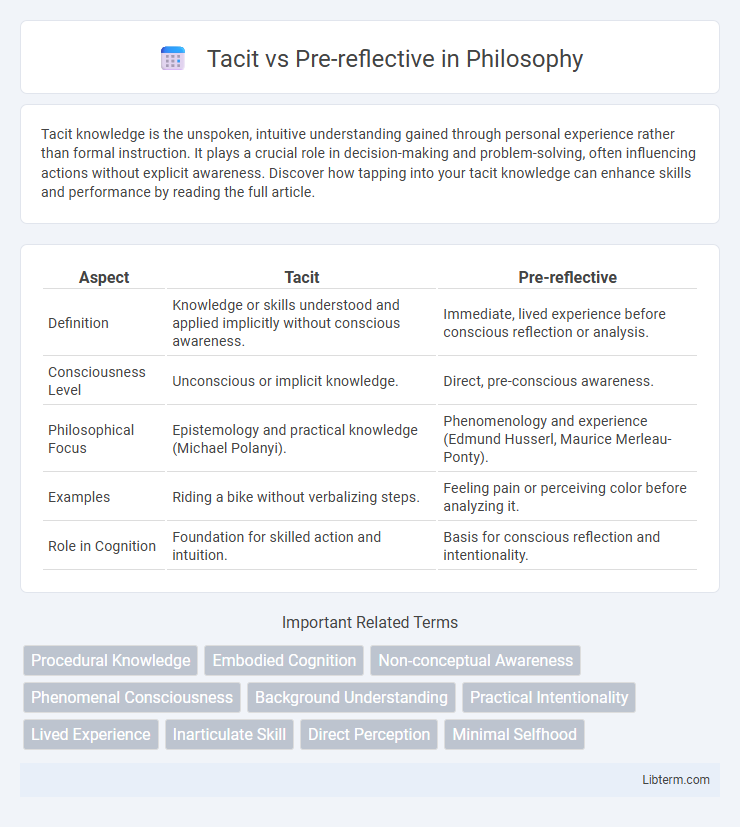Tacit knowledge is the unspoken, intuitive understanding gained through personal experience rather than formal instruction. It plays a crucial role in decision-making and problem-solving, often influencing actions without explicit awareness. Discover how tapping into your tacit knowledge can enhance skills and performance by reading the full article.
Table of Comparison
| Aspect | Tacit | Pre-reflective |
|---|---|---|
| Definition | Knowledge or skills understood and applied implicitly without conscious awareness. | Immediate, lived experience before conscious reflection or analysis. |
| Consciousness Level | Unconscious or implicit knowledge. | Direct, pre-conscious awareness. |
| Philosophical Focus | Epistemology and practical knowledge (Michael Polanyi). | Phenomenology and experience (Edmund Husserl, Maurice Merleau-Ponty). |
| Examples | Riding a bike without verbalizing steps. | Feeling pain or perceiving color before analyzing it. |
| Role in Cognition | Foundation for skilled action and intuition. | Basis for conscious reflection and intentionality. |
Introduction to Tacit and Pre-reflective Knowledge
Tacit knowledge refers to the intuitive, unarticulated understanding gained through personal experience and practice, often difficult to formalize or communicate. Pre-reflective knowledge involves the immediate, non-conceptual awareness of situations and actions prior to deliberate analysis or reflection. Both forms of knowledge emphasize implicit cognition, crucial in fields such as skill acquisition, phenomenology, and embodied cognition studies.
Defining Tacit Knowledge
Tacit knowledge refers to the implicit, unarticulated understanding acquired through personal experience and practice, often difficult to formalize or communicate. It contrasts with pre-reflective knowledge, which is immediate and non-conceptual awareness occurring without conscious reflection. Defining tacit knowledge involves recognizing its foundation in personal skills, intuition, and situational judgment that guide actions beyond explicit instructions.
Understanding Pre-reflective Awareness
Pre-reflective awareness refers to the immediate, non-conceptual experience of phenomena before conscious reflection or explicit thought. It underlies tacit knowledge, enabling intuitive understanding without deliberate analysis or articulation. This form of awareness is fundamental in phenomenology, highlighting how individuals engage with the world through direct, lived experience rather than cognitive mediation.
Historical Background of Tacit and Pre-reflective Concepts
The historical background of tacit and pre-reflective concepts traces back to early philosophy and cognitive science, with Michael Polanyi introducing "tacit knowledge" in the mid-20th century to describe knowledge that is personal and hard to formalize. Pre-reflective experience, rooted in phenomenology, was extensively explored by Edmund Husserl and Maurice Merleau-Ponty, emphasizing the immediacy of lived experience before conscious reflection. This distinction shaped contemporary understanding of implicit cognition and embodied knowledge in epistemology and psychology.
Key Differences Between Tacit and Pre-reflective Knowledge
Tacit knowledge encompasses skills and know-how that individuals acquire through experience without easily articulable details, whereas pre-reflective knowledge refers to the immediate, non-conscious awareness present before deliberate reflection. Tacit knowledge is often context-dependent and difficult to formalize, contrasting with pre-reflective knowledge that underlies spontaneous perceptions and actions without explicit recognition. The key difference lies in tacit knowledge being accumulated and internalized over time, while pre-reflective knowledge operates in the moment as embodied, intuitive understanding.
The Role of Tacit Knowledge in Everyday Life
Tacit knowledge plays a crucial role in everyday life by enabling individuals to perform complex tasks without conscious awareness, such as riding a bicycle or recognizing facial expressions. This pre-reflective understanding operates below explicit reasoning, allowing seamless interaction with the environment based on accumulated experience. The integration of tacit knowledge supports decision-making and problem-solving in familiar contexts, demonstrating its importance beyond formal, reflective thought processes.
Pre-reflective Experience in Human Cognition
Pre-reflective experience in human cognition refers to the immediate, non-conceptual awareness of sensory and bodily states that occurs prior to reflective thought or deliberate analysis. This foundational layer of cognition enables seamless interaction with the environment by grounding perception and action in a direct, embodied sense of being. Understanding pre-reflective experience is essential for exploring how humans integrate unconscious sensory data into conscious reflective processes.
Interplay and Overlap: Tacit vs Pre-reflective
The interplay between tacit and pre-reflective knowledge reveals a complex overlap where tacit knowledge encompasses unarticulated skills and insights gained through experience, while pre-reflective awareness involves immediate, non-conceptual consciousness of actions and perceptions. Both modes operate beneath explicit cognition, yet pre-reflective knowledge emphasizes moment-to-moment embodied experience, forming the foundation upon which tacit knowledge is built and accessed. Understanding their overlap enhances cognitive science and phenomenology by clarifying how implicit understanding informs spontaneous behavior and skilled expertise.
Implications for Learning and Skill Development
Tacit knowledge, often unspoken and acquired through experience, contrasts with pre-reflective awareness, which involves intuitive, automatic understanding without deliberate reflection. Recognizing this distinction enhances skill development by emphasizing experiential learning and situational practice, fostering deeper internalization of competencies. Educational strategies that incorporate real-life contexts and hands-on activities support the transition from pre-reflective intuition to articulate, tacit expertise, optimizing cognitive and procedural skill acquisition.
Conclusion: Integrating Tacit and Pre-reflective Insights
Integrating tacit and pre-reflective insights enhances understanding by combining unconscious knowledge with immediate, non-conceptual experience. This synthesis allows for more intuitive decision-making and richer cognitive processing. Emphasizing their interplay fosters a deeper grasp of human cognition and practical skill acquisition.
Tacit Infographic

 libterm.com
libterm.com